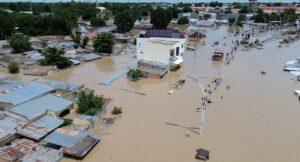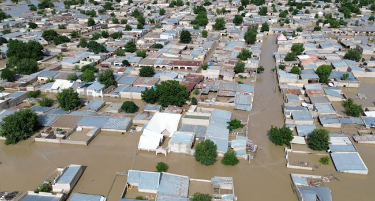The Federal Government has once again called on Nigerians to take urgent steps to clear their canals, drainages, and gutters to help mitigate the devastating effects of floods. This appeal comes as water levels at key stations along the River Benue have shown a steady rise, inching closer to dangerous flood levels. The Nigeria Hydrological Services Agency (NIHSA) issued an updated report over the weekend, cautioning that while the situation remains at a flood preparedness level for now, immediate actions must be taken to prevent a full-scale disaster.
In a statement released by the agency’s Head of Media and Publicity, Lauretta Samuel, NIHSA noted that as of Saturday, water levels at critical points across the country continue to rise. This is of particular concern to the twelve states previously identified as being highly prone to floods. Samuel urged these states to activate their flood preparedness plans and put measures in place to manage the potential overflow and reduce the impact on vulnerable communities.
 The agency has been closely monitoring the situation, especially following recent incidents like the devastating flooding in Maiduguri, Borno State. The overflow of the Alau Dam caused one of the worst flood disasters in the history of Nigeria, leaving widespread destruction in its wake. Entire communities in Maiduguri were submerged, thousands of residents were displaced, and essential infrastructure was severely damaged. This tragedy highlights the urgent need for better flood management and preparedness across the country.
The agency has been closely monitoring the situation, especially following recent incidents like the devastating flooding in Maiduguri, Borno State. The overflow of the Alau Dam caused one of the worst flood disasters in the history of Nigeria, leaving widespread destruction in its wake. Entire communities in Maiduguri were submerged, thousands of residents were displaced, and essential infrastructure was severely damaged. This tragedy highlights the urgent need for better flood management and preparedness across the country.
Flooding has become a recurring issue in Nigeria, particularly during the rainy season, with states along the Niger and Benue Rivers being the most affected. The combination of poor drainage systems, clogged gutters, and inadequate urban planning often leads to severe flooding, leaving destruction and hardship in its path. As a result, the Federal Government, through NIHSA, is emphasizing the importance of clearing water channels to ensure the free flow of water and prevent excessive buildup.
The twelve states that have been repeatedly warned by NIHSA to brace for possible flooding include Adamawa, Taraba, Benue, Niger, Anambra, Kogi, Kebbi, Kwara, Jigawa, and parts of Lagos, Delta, and Rivers. These states are particularly vulnerable due to their proximity to rivers and dams, and many communities within these areas are often hardest hit during the flood season.
Floods not only wreak havoc on lives and properties but also have long-lasting consequences on food security and the economy. In agricultural areas, crops and livestock are often destroyed, leading to food shortages and a spike in prices. Roads, bridges, and other critical infrastructure also suffer substantial damage, disrupting the movement of goods and people. For communities already grappling with poverty, such disasters only compound their problems, making recovery an uphill battle.
In the statement, NIHSA stressed the importance of proactive steps to reduce the risks associated with flooding. According to Samuel, “It is vital for residents, especially in flood-prone areas, to take responsibility for their environment by ensuring that their gutters, canals, and drainages are free of debris.” Blocked waterways are a major contributing factor to urban flooding, as they prevent water from flowing freely, leading to overflow and pooling in residential areas.
The agency also called on local governments and state authorities to intensify their efforts in sensitizing the public about the dangers of flooding and the role everyone must play in reducing its impact. In many parts of Nigeria, drainage systems are poorly maintained or even non-existent, and residents often dispose of waste in gutters and canals, further exacerbating the problem. Without concerted efforts to change these practices, the risk of severe flooding remains high.
Beyond clearing drainages, NIHSA is also urging the affected states to improve their flood management infrastructure, such as building more effective flood barriers, reinforcing embankments, and investing in early warning systems. Such measures could go a long way in helping to contain floodwaters and minimize the damage caused.
The flood forecast for this year, according to NIHSA, is particularly concerning due to the higher-than-usual rainfall in the country, as well as the rising water levels in rivers and dams. As the rainy season progresses, the risks become even more pronounced, especially in communities situated near rivers. In addition to the threat from local rainfall, water releases from dams in neighboring countries, such as Cameroon’s Lagdo Dam, have historically contributed to flooding in Nigeria. This makes it even more crucial for local governments to be on high alert and have contingency plans in place.
As the government continues to monitor the situation, it is also calling for cooperation from residents to ensure that flood prevention efforts are successful. While national and state authorities have a major role to play in flood mitigation, individual citizens also need to take responsibility for their immediate environment. This includes ensuring that waste is properly disposed of, not blocking drainage systems, and heeding evacuation warnings when necessary.
In conclusion, the threat of flooding in Nigeria remains significant, with many parts of the country at risk due to rising water levels and poor drainage systems. The Federal Government, through NIHSA, has made it clear that swift action is needed to avoid a repeat of the catastrophic flooding witnessed in Maiduguri and other flood-prone areas. By clearing canals, drainages, and gutters, both the government and residents can work together to mitigate the risk of floods and protect lives and property. However, without sustained efforts and cooperation, the consequences could be severe, leaving communities vulnerable to yet another round of devastating floods.




